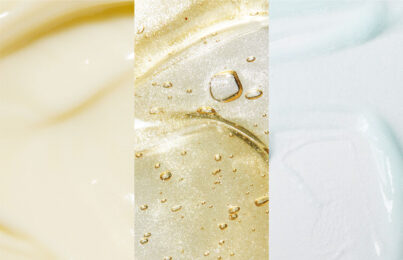Updated 06/08/22. If you’re prone to breakouts, you surely pay attention to ingredient labels when you’re buying new skincare products. You want to avoid potentially pore-clogging ingredients and understandably so. One class of ingredients that has a particularly bad reputation for causing breakouts is silicones. Some people say they clog pores and should be avoided at all costs, but what’s the truth? Keep reading for a crash course on silicones in skincare!
- Do Silicone Ingredients Cause Breakouts?
- Are Silicone Ingredients Safe?
- Are Silicones Comedogenic?
- 3 Fast Facts About Silicones in Skincare
- PROS of Silicones in Skincare
- CONS of Silicones in Skincare
- Silicones That Are Suitable For Oily, Blemish-Prone Skin
- Silicones That Are Unsuitable For Oily, Blemish-Prone Skin
- Silicones That Could Be Good or Bad For Oily, Blemish-Prone Skin
- The Silicone Test
- So, Should I Use Silicone Ingredients?
Do Silicone Ingredients Cause Breakouts?
The simple answer is no, silicone ingredients don’t necessarily cause breakouts. In fact, most silicones are agreeable to breakout-prone skin! It all comes down to which kind you use and what other ingredients are included in the formula, as I’ll explain.
Are Silicone Ingredients Safe?
Despite recent confusion, silicones are very safe ingredients. I spoke with Ron Robinson, a cosmetic chemist and founder of Beauty Stat about the safety of silicones. “With the clean beauty movement, some companies deem silicone-containing products as not fitting their clean standards,” Robinson said. “I disagree with this theory given the amount of data on silicones compared to many other natural ingredients that are considered clean, yet have little data to support this.”
You can rest assured that a product isn’t unsafe or ineffective just because it contains silicone ingredients. Actually, it’s often the exact opposite. As I said before, it all comes down to the type of silicone used and the other ingredients used in the formula.
Are Silicones Comedogenic?
Comedogenicity is a term that gets thrown around a lot in skincare, so first, let me define what it actually means.
“Comedogenic” is a technical term for “pore-clogging.” Since many of my products are designed to benefit breakout-prone skin, I’ve studied comedogenicity quite extensively in cosmetic chemistry courses as well as in the lab when formulating products. Essentially, comedogenicity refers to how likely certain topical agents (primarily emollients) are to cause closed comedones or clogged pores. A product or ingredient that causes comedones to develop is considered comedogenic.
We also need to consider the science behind breakouts and how they happen in the first place. It all comes down to cell buildup and an overproduction of oil. Here’s how it works. Dead skin cells begin to build up. Then, they get coated in oil and become trapped in the follicle walls. Once this happens, blemish-causing bacteria are able to thrive.
It’s true that when applied to the skin’s surface, SOME oils, emollients, and silicones further coat these follicle walls. This can potentially exacerbate breakout conditions. So, basically, it depends on the specific silicone ingredient (more on that in a minute).
3 Fast Facts About Silicones in Skincare
- They’re a class of ingredients, which is why you’ll never just see the word “silicone” listed on a product.
- They offer far more benefits than risks.
- Not all silicones remain on the skin after they’re applied due to different rates of volatility.*
*Volatility can best be described as the degree to which a molecule wants to be airborne into the atmosphere. It’s the speed of the ingredient evaporation. Usually, smaller molecules want to be airborne (example: isopropyl alcohol) and the heavier ones don’t (example: Vaseline). You can correlate volatility with weight.
PROS of Silicones in Skincare
- They deliver a smooth, soft, and velvety texture to the skin.
- They help deposit active ingredients evenly across the skin.
- Silicones diffuse light to soften the look of lines, wrinkles, and pores.
- They’re hypoallergenic and won’t sensitize the skin.
- They can offset dryness caused by harsh acne products.
- Silicones can help manage flakiness and cracking associated with eczema and psoriasis.
- They feel lightweight and non-greasy, making them ideal for oily skin types.
- They can protect the skin from environmental pollutants by creating a “breathable” barrier over the skin that still allows nitrogen, oxygen, and water vapors to pass through.
- Silicones help prevent transepidermal water loss (TEWL) to keep skin feeling moist.
- Silicones can increase penetration of other ingredients.*
*This can also be a con. See below.
CONS of Silicones in Skincare
- They can increase the penetration of some other ingredients, which could lead to clogged pores. If there are ingredients in a formula that aren’t compatible with oily, breakout-prone skin types, the silicone ingredients may facilitate a blockage in the pore lining. This is what can potentially lead to clogged pores and blemishes, but it’s not the silicone itself. Also, it’s worth noting that not all silicones have the ability to do this. See below.
Silicones That Are Suitable For Oily, Blemish-Prone Skin
The following silicones are lightweight and have relatively high volatility. This means they have a tendency to evaporate and don’t linger on the skin or create an occlusive barrier.
Cyclopentasiloxane
This ingredient allows skincare products to glide nicely onto the skin without leaving a residue. After a few moments, it evaporates from the skin, leaving other ingredients behind. Anyone who’s concerned about products creating an occlusive barrier shouldn’t worry about Cyclopentasiloxane, because it essentially acts as a carrier and then goes away.
Cyclomethicone
This silicone is a blend of Cyclopentasiloxane and Cyclotetrasiloxane, which have high volatility, making them evaporate after some time. This makes Cyclomethicone non-occlusive and perfectly suitable for oily, blemish-prone skin.
Cyclohexasiloxane
Cyclohexasiloxane is a blend of siloxanes with fairly high volatility. They should be easily tolerated by oily, blemish-prone skin.
Silicones That Are Unsuitable For Oily, Blemish-Prone Skin
The following silicones have low volatility, which means they don’t really evaporate off the skin and can create an occlusive barrier. This may not be ideal for oily, blemish-prone skin or those who are prone to clogged pores. Remember, this doesn’t make them “bad” ingredients—these silicones are still excellent ingredients for those with drier skin types!
Dimethiconol
Dimethiconol stays on the skin and doesn’t evaporate. This can be beneficial for dry skin, but not for oily, blemish-prone skin.
Cetearyl Methicone
This is a soft silicone wax that coats the skin and provides slip to a formulation. It’s considered a good occlusive for dry skin types in need of moisture barrier support. However, because of this, it’s not deal for breakout-prone skin.
To reiterate, it’s NOT the silicone itself that causes issues with blemish-prone skin types. It’s only if the formula includes other heavy ingredients that the silicone allows to be pushed deeper into the pore. If there aren’t any other heavy ingredients in a formula, these silicones shouldn’t technically cause any problems in blemish-prone skin.
Silicones That Could Be Good or Bad For Oily, Blemish-Prone Skin
Sometimes, you can’t tell how likely a silicone is to clog pores. It may depend entirely on how it’s formulated.
Dimethicone
This one is quite complicated because it can have many different weights. A formulator can use dimethicone that’s extremely volatile. Or, a formulator may use dimethicone with no volatility, causing it to stay on the skin and carry other potentially pore-clogging ingredients into the pores. It’s almost impossible for me as a formulator, let alone you as a consumer, to look at an ingredient label and know which weight of dimethicone was used. You just can’t assume anything when you see dimethicone on an ingredient list.
The Silicone Test
I decided to do a test to demonstrate how different kinds of silicone ingredients act on the skin. My goal was to provide you with a visual representation for all the information I’ve provided, as well as to show how much composition matters!
![]()
To start, I got samples of three different silicones from the lab and put a few drops of each on paper. I tested Cyclopentasiloxane as well as two different dimethicone samples—one with low molecular weight and one with high molecular weight.
![]()
After 45 minutes, you can start to see how long each silicone stays in its form. This is an indicator of volatility (the rate at which something evaporates). You can also see that the more volatile formulas spread out more before evaporating, which might influence how and when a cosmetic formulator decides to use them.
One thing you can’t tell from the photo is the consistency of each silicone. Both the Cyclopentasiloxane (on the left) and the highly volatile Dimethicone (in the middle) are the consistency of water but with a slippery, silky feel. The non-volatile Dimethicone (on the right) is a thicker consistency like that of syrup, but also with a silky feel.
![]()
After two hours, both the Cyclopentasiloxane and the more volatile Dimethicone had evaporated entirely. This indicates that they would not coat the skin as much as the higher molecular weight Dimethicone on the right. The Dimethicone on the right would be better for staying in place and creating an occlusive layer over the skin.
The Conclusion
The first two silicones are fast-drying and would not provide a long-lasting occlusive effect, so neither should be problematic for oily, blemish-prone skin. They would also both give a product a nice, smooth texture and good spreadability.
The Dimethicone on the right has a higher molecular weight than the first two silicones, so it would coat the skin instead of evaporating. It would create a barrier, making it ideal for dry skin but not for oily skin—especially if there are other pore-clogging ingredients used within the same formula.
Needless to say, not all silicones are the same! I hope this demonstration gives you a glimpse into just how differently various silicones can act on the skin. There is so much variation among the ingredients that fall under the umbrella of ‘silicones’ and there’s no reason to swear them all off. It’s just about choosing the ones that are compatible with your skin type.
So, Should I Use Silicone Ingredients?
If you like the look and feel of your skin when you use silicone products then keep using them. However, if you think a silicone product might be causing breakouts, it could very well be from another ingredient in the formula. I recommend that you try a different formula but not rule out silicone entirely.
The most important point I’d like to make about skincare formulas is that you can’t judge a product by an ingredient label. It all depends on your unique skin type, as well as the percentages of the ingredients used in a product—and you’ll never know these percentages from just looking at the ingredient label.
Simply put, you can’t tell the true effect of a product until you actually try it. This is why I always suggest only introducing one new product at a time, as well as doing a patch test before you use it over your entire face. This way, if your skin responds negatively, you can at least pinpoint which product it might be.
Next, learn how to hydrate oily, blemish-prone skin without causing breakouts.
Celebrity Esthetician & Skincare Expert
As an esthetician trained in cosmetic chemistry, Renée Rouleau has spent 35 years researching skin, educating her audience, and building an award-winning line of products. Her hands-on experience as an esthetician and trusted skin care expert has created a real-world solution — products that are formulated for nine different types of skin so your face will get exactly what it needs to look and feel its best. Trusted by celebrities, editors, bloggers, and skincare obsessives around the globe, her vast real-world knowledge and constant research are why Marie Claire calls her “the most passionate skin practitioner we know.”


